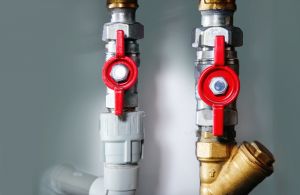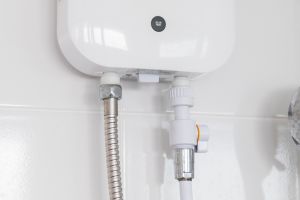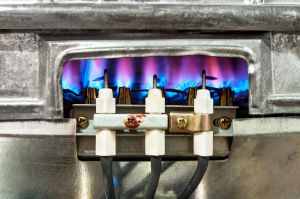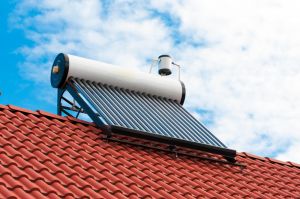Continuous Hot Water System Installation Cost
 Fact Checked
Fact Checked
Whether you're in the market for a hot water system for a new build or looking to replace an existing unit with new and improved technology, it's important to understand ALL costs involved in the installation of a water heater. We cover everything you need to know to make an informed purchase decision and avoid cold showers.
Types of hot water systems
Before you delve into dollars, let's look into the existing types of hot water systems available in Australia. There are two main types of hot water systems: storage systems and continuous flow (or instantaneous) systems − available with either electricity, gas (LPG or natural gas), or solar power.
- Storage hot water systems are comprised of an insulated tank where water is kept heated at all times. Cold water is heated by elements made from either copper or nickel-chrome alloy inside the storage tank. These can be installed indoors or outdoor. Larger units can easily supply hot water to multiple outlets at the same time, meaning you can run the hot tap in the kitchen without losing hot water to the shower.
- Instantaneous hot water systems (also known as continuous flow or tankless systems) don't have storage tanks and heat water instantly (hence the name) by flowing through a coiled pipe called a heat exchanger. Continuous flow systems are more suited to smaller households where space is limited. They're more energy efficient because there's no heat loss from a tank. The downside is that there could be a slight delay in heating up the water.
Read more: Your complete guide to hot water systems
Gas vs electric hot water systems: What's best?

Choosing between a gas vs electric water heater will depend on:
- Available power source(s) at your property (i.e. natural gas connection, solar, etc.)
- How big your household is and your water usage (i.e. larger families may benefit from gas-powered systems)
- How much space you have at home (i.e. electric continuous flow systems are best for smaller homes)
- Your budget (i.e if you want to invest in a top-of-line system or change connection)
- If you want to keep running costs to a minimum (i.e. go green with a solar-powered or gas-powered system)
Electric hot water systems
A Canstar Blue survey found that 44% of Aussies have an electric water heater. Electric hot water systems (available as both storage or instantaneous systems) are the most commonly used because they're fairly cheap to buy and install (and because there are fewer available natural gas mains supply networks in metropolitan areas). You can also get a replacement electric hot water system up and running for cheap in no time, which is what makes them so appealing to households on a budget. There are, however, notoriously inefficient to run, but you can make use of time-of-use tariffs to heat water overnight when electricity rates are cheaper, although you'll need a big enough storage tank to last a full day. Off-peak storage systems only work outside of peak times.
Heat pump hot water systems are also the electric hot water system category and are far more (as a hybrid option) but are far more energy efficient because they extract heat from the surrounding air to heat water, as opposed to relying on electrical currents.
Read more: Peak and off-peak electricity times explained
Gas hot water systems
On the other hand, gas hot water systems (also available as storage or instantaneous systems) use either LPG bottled gas or natural gas as an energy source. These are notably more expensive to buy and install, but much more economical to run in the long term because natural gas is cheaper than electricity, even without off-peak tariffs. Natural gas is also cheaper than LPG gas. Gas systems are also generally smaller than electric tanks which makes them ideal for smaller households. They also heat water much faster. Keep in mind that switching from electric to gas will require the installation of new gas lines by a qualified gas fitter which will add to the overall cost. A Canstar Blue survey found that 37% of Aussies have a gas water heater.
Solar hot water systems
Then, there are solar hot systems aka the preferred 'green' choice on the market. They're one of the most common types of systems installed in new homes as they harvest the power of the sun (renewable energy) to heat water rather than electricity or gas. This makes them highly energy-efficient, although the initial setup will set you back more. These systems consist of several solar panels installed on your roof, but they're still connected to electricity or gas to boost your energy supply in winter or on overcast days. Rebates are available for solar customers. Only 11% of Aussies have a solar-powered water heater, according to a Canstar Blue survey.
| Electric hot water | Gas hot water | Solar hot water |
| Low upfront cost | Cheaper to run with a natural gas connection | Cheapest to run |
| Easy to install | Supply hot water even during a power outage | Customers may be eligible for rebates & government incentives |
| Produce hot water on demand | No off-peak tariffs to worry about | Fitted with gas or electric fuel booster for overcast days |
| Can make use of off-peak times | Fewer greenhouse gas emissions | Most environmentally friendly |
New hot water system installation cost
Hot water system installation costs can range widely between $1,000 and upwards of $7,000, depending on factors like:
- Your household's water usage: As a general rule, each person will typically use 50L of hot water per day, so if you've got a family of four, you're looking at 200L of hot water daily. This will also include when everyone uses hot water most (usually morning and evenings) and how many bathrooms and outlets your system will need to serve. Depending on your usage requirements, some hot water systems will be more economical than others in the long term.
- Tank size: Tank capacities vary from 50L to 400L. The larger the tank capacity of your water heater, the higher your upfront and installation costs will be.
- The type of system you want: Electric hot water systems are generally the cheapest to buy, followed by gas models, solar units, and heat pump systems are the most expensive. This includes the price of the hot water system, the size and shape, the brand you choose, and the difference in installation costs for different system types.
- Labour costs: All water heaters will need to be installed by a licensed plumber and possibility an electrician if you've got an electric or hybrid model. A simple installation can take around two to three hours and more complex ones (i.e. extra fittings, etc.) can take upwards of four hours. Plumbers and electricians can charge between $80-$120 an hour.
- Materials: Installation costs will also include the cost of materials such as all the necessary pipes, valves, and fittings. It's a requirement under Australian law for all storage hot water tanks to have tempering valves to prevent scalding accidents.
- Replacement: Replacing your water heater with a similar unit will be fairly inexpensive as it typically requires a plumber to simply swap your old unit with a new one. However, you will pay more if need you to reposition the hot water system or replace your electric model with a gas unit.
- Government rebates: Solar and heat pump hot water systems may qualify for government rebates of up to 1,000 and Small-Scale Technology Certificates (STCs), depending on which state you live in. These are similar to solar feed-in tariffs, in that customers who install solar pumps are eligible to receive financial incentives for their use of clean and renewable energy.
- Your budget: How much you're willing to spend on a new or replacement system.
Electric hot water system installation cost – Cheapest

Electric water heaters are the cheapest to install − typically costing between $1,000-$2,000 – inclusive of the cost of the unit, materials (i.e. pipes, etc.), labour, and fittings. This is because they're fairly easy to install. They connect to existing electric power outlets and operate on quite a simple mechanism. Systems that require an electrical upgrade or need repositioning will cost more to install.
Overall installation costs will be determined by factors including:
- Tank size (storage hot water systems only): Can typically hold between 25L-400L of water. Dependent on your household size and water usage.
- Complexity of installation: If you need to add extra power cables or water main pipes under the house. This will also include how accessible your property is.
- Labour costs: You'll need a licensed electrician and plumber to install, replace or upgrade your electric hot water system.
- Materials used: This will include the thermostat, dip tubes, pipes, valves, and insulating materials.
- Disposal of old system: If you're replacing an existing hot water system, you'll need to pay to get your old one disposed of safely. Most companies will include this service with your purchase as an added fee.
Electric hot water system replacement cost
Electric hot water systems are also the cheapest to replace. You could pay about $300-$700 if it's a simple change-out with a similar model installed in the same spot. The bulk of this cost would be labour and fittings. Just keep in mind that any savings in replacement or installation costs will be quickly eroded by your running costs, including usage rates, daily supply charges, etc.
Read more: How to reduce the cost of your hot water bill
Gas hot water system installation cost – Mid-range

Both storage and instantaneous gas water heaters are slightly more expensive to install than their electric counterparts, depending on whether you already have an accessible gas supply line or not. Costs will vary typically between $1,500-$3,000. If you don't have a connection to natural gas there is the option to use LPG bottles, but you'll need to organise bottle swaps which isn't always convenient. Upfront costs aside, gas hot water systems are cheaper to run (because natural gas is cheaper than electricity). Gas continuous flow systems are typically cheaper to install because they're tankless.
Overall installation costs will be determined by factors including:
- The system's size: This will be determined by how many bathrooms and taps your system will service and your household's water usage (measured in litres).
- Type of installation: Whether you're opting for a storage or instantaneous gas hot water system.
- Gas connection: Whether you require a new gas line connection (which can cost upwards of $2,000) or require LPG gas fitting (which is considerably cheaper).
- Materials used: This will include the thermostat, dip tubes, pipes, valves, and insulating materials.
- Labour costs: Connecting to a natural gas supply requires the services of a licensed gas fitter. You'll need to hire a licensed plumber as well. These costs alone can add up to $500-$900.
Read more: Gas hot water system prices & usage costs
Gas hot water system replacement cost
A gas hot water system replacement with a like-for-like system will typically cost between $500 and $800. Replacements are cheaper than installations because they don't involve much work. However, if you're switching from an electric water heater to a gas model, prices will typically be steeper or upwards of $1,500.
Solar hot water system installation cost – Most expensive

Solar water heaters are the most energy-efficient of all hot water systems (even compared to gas), but they're the most expensive to install, to the tune of $3,000-$7,000. This is because there's an added level of complexity with solar hot water systems, including whether you use flat plate or evacuated tub collectors, which backup system you use, the configuration of your roof, and so on.
Overall installation costs will be determined by factors including:
- Installation type: Systems with a roof-mounted tank are typically less expensive to install than split systems installed in separate locations.
- System size: Dependent on your household size and usage habits, and how many taps and outlets your system will need to service. Account for about 50L per household member.
- Booster system (for days without sunshine): Electric-boosted systems are less expensive than gas-boosted systems (which can cost around $500 to $1,000).
- Materials used: This will include the thermostat, dip tubes, pipes, valves, and insulating materials.
- Complexity of installation: This depends on your roof type and how easy it can be accessed (i.e. high-pitched roofs make for more difficult installations).
- Location: Rebates are available in some states and territories. Solar and heat pump hot water systems could be eligible for renewable power incentives in the form of Small-Scale Technology Certificates (STCs).
Be sure to have your solar hot water system installed by an accredited installer. All solar hot water system warranties and Government rebates require installation by an accredited installer from the Clean Energy Council list. Also, you will want to ensure your solar hot water system is properly installed. It's always wise to seek several quotes from different installers.
Read more: Solar hot water system prices & usage costs
Solar hot water system replacement cost
Replacement costs for solar hot water systems are also cheaper since the solar mounts and hardware will already be in place. Most solar hot water systems (for a four-person household) will have one or two solar panels that need replacing as well as valves. Roof-mounted systems are usually cheaper to replace than split systems. Keep in mind that replacing your solar hot water system with an identical model isn't always the most economical option in the long term as better technology may exist that could be more efficient and reliable.
Compare Hot Water Systems
Source: https://www.canstarblue.com.au/appliances/hot-water-system-installation-cost/

0 Response to "Continuous Hot Water System Installation Cost"
Post a Comment